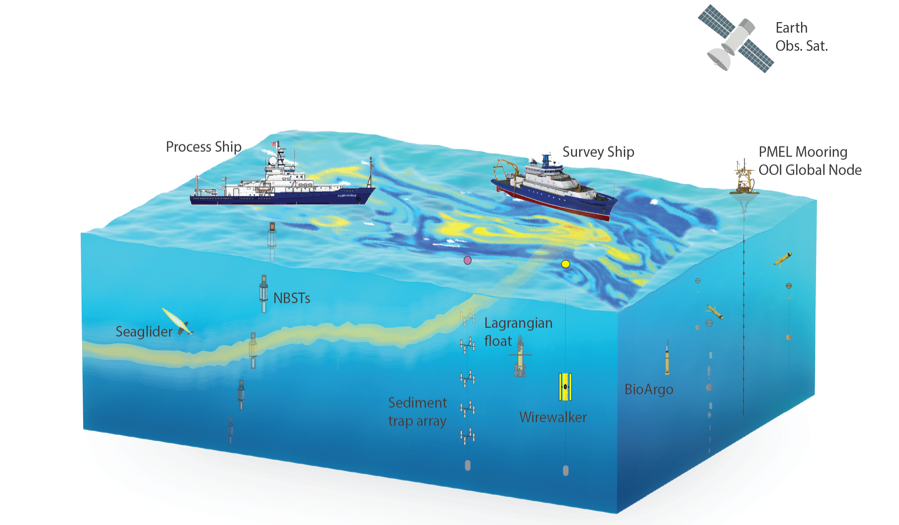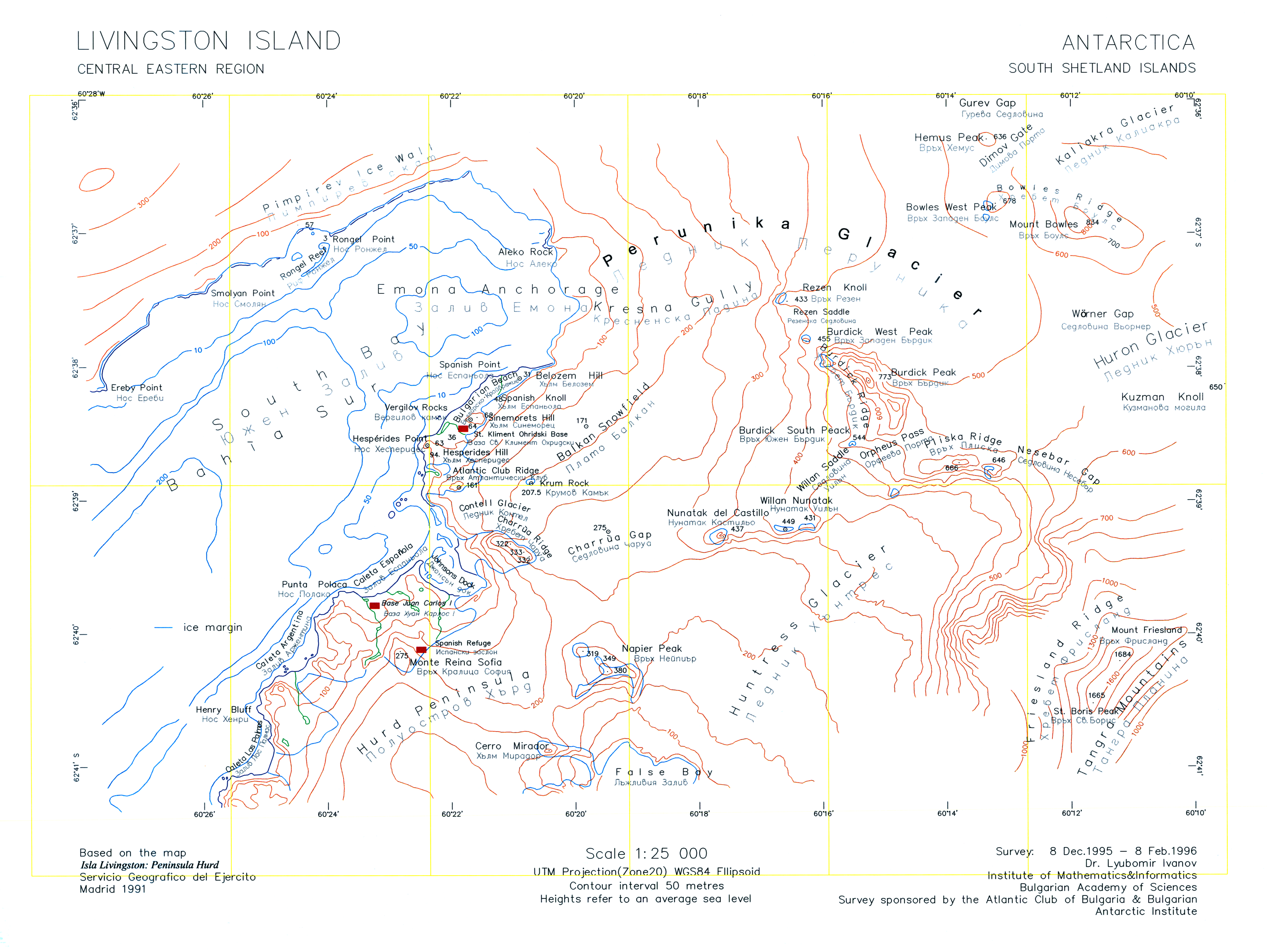|
Rongel Point
Rongel Point (Nos Rongel \'nos ron-'zhel\) is an ice-covered headland on the northwest coast of South Bay, Livingston Island in the South Shetland Islands, Antarctica. The area was visited by 19th century sealers operating from nearby Johnsons Dock. The feature takes its name from nearby Rongel Reef named after the Brazilian Navy research vessel ''Ary Rongel'', in recognition of her logistic support for the Bulgarian Antarctic campaigns. Location Ary Rongel Point is located at , which is 1.3 km northeast of Smolyan Point, 4 km west of Aleko Point and 3.5 km northwest of Hespérides Point. Bulgarian mapping from a topographic survey of the region made from 8 December 1995 to 8 February 1996; the coastal configuration in the area was altered subsequently as a result of Pimpirev Glacier's retreat in the late 20th and early 21st centuries. Maps Isla Livingston: Península Hurd.Mapa topográfico de escala 1:25000. Madrid: Servicio Geográfico del Ejército, 1991. ... [...More Info...] [...Related Items...] OR: [Wikipedia] [Google] [Baidu] |
Research Vessel
A research vessel (RV or R/V) is a ship or boat designed, modified, or equipped to carry out research at sea. Research vessels carry out a number of roles. Some of these roles can be combined into a single vessel but others require a dedicated vessel. Due to the demanding nature of the work, research vessels may be constructed around an icebreaker hull, allowing them to operate in polar waters. History The research ship had origins in the early voyages of exploration. By the time of James Cook's ''Endeavour'', the essentials of what today we would call a research ship are clearly apparent. In 1766, the Royal Society hired Cook to travel to the Pacific Ocean to observe and record the transit of Venus across the Sun. The ''Endeavour'' was a sturdy vessel, well designed and equipped for the ordeals she would face, and fitted out with facilities for her "research personnel", Joseph Banks. As is common with contemporary research vessels, ''Endeavour'' also carried out more than ... [...More Info...] [...Related Items...] OR: [Wikipedia] [Google] [Baidu] |
Antarctic Place-names Commission
The Antarctic Place-names Commission was established by the Bulgarian Antarctic Institute in 1994, and since 2001 has been a body affiliated with the Ministry of Foreign Affairs of Bulgaria. The Commission approves Bulgarian place names in Antarctica, which are formally given by the President of the Republic according to the Bulgarian Constitution (Art. 98) and the established international practice. Bulgarian names in Antarctica Geographical names in Antarctica reflect the history and practice of Antarctic exploration. The nations involved in Antarctic research give new names to nameless geographical features for the purposes of orientation, logistics, and international scientific cooperation. As of 2021, there are some 20,091 named Antarctic geographical features, including 1,601 features with names given by Bulgaria.Bulgarian Antarctic Gazett ... [...More Info...] [...Related Items...] OR: [Wikipedia] [Google] [Baidu] |
Composite Antarctic Gazetteer
The Composite Gazetteer of Antarctica (CGA) of the Scientific Committee on Antarctic Research (SCAR) is the authoritative international gazetteer containing all Antarctic toponyms published in national gazetteers, plus basic information about those names and the relevant geographical features. The Gazetteer includes also parts of the International Hydrographic Organization (IHO) General Bathymetric Chart of the Oceans (GEBCO) gazetteer for under-sea features situated south of 60° south latitude. , the overall content of the CGA amounts to 37,893 geographic names for 19,803 features including some 500 features with two or more entirely different names, contributed by the following sources: {, class="wikitable sortable" ! Country ! Names , - , United States , 13,192 , - , United Kingdom , 5,040 , - , Russia , 4,808 , - , New Zealand , 2,597 , - , Australia , 2,551 , - , Argentina , 2,545 , - , Chile , 1,866 , - , Norway , 1,706 , - , Bulgaria , 1,450 , - , G ... [...More Info...] [...Related Items...] OR: [Wikipedia] [Google] [Baidu] |
Pimpirev Glacier
Pimpirev Glacier ( bg, Пимпирев ледник, Pimpirev lednik, ) on Livingston Island in the South Shetland Islands, Antarctica is situated south of the glacial divide between the Drake Passage and Bransfield Strait, southeast of Tundzha Glacier, southwest of Saedinenie Snowfield, west of Perunika Glacier and east-northeast of Kamchiya Glacier. The feature extends 5.5 km in a southeast-northwest direction, and 1.8 km in northwest-southeast direction. The glacier drains southeastwards towards Pimpirev Beach, mostly terminating on the shore, and on several occasions penetrating the South Bay waters east-northeast of Ereby Point. The feature is named for Christo Pimpirev, geologist in the First Bulgarian Antarctic Expedition in 1987/88 and leader of subsequent national Antarctic campaigns. The original name '' Pimpirev Ice Wall'' was given on October 29, 1996 to the 50-m high rectilinear ice scarp-slope running parallelly to and some 100 m inland from the coa ... [...More Info...] [...Related Items...] OR: [Wikipedia] [Google] [Baidu] |
Hespérides Point
Hespérides Point ( es, Punta Hespérides) is a rocky point of land projecting into South Bay north-northwest of Johnsons Dock, Livingston Island in the South Shetland Islands, Antarctica and forming the southwest side of the entrance to Emona Anchorage. Surmounted by Hesperides Hill. The area was visited by 19th century sealers operating from nearby Johnsons Dock. The feature is named after the Spanish ocean exploration ship BIO Hesperides. Location The point is located at which is 12.36 km east-northeast of Hannah Point, 3.7 km southeast of Smolyan Point and 1.59 km north of Ballester Point Ballester Point ( bg, text=нос Балестер, italic=no, ‘Nos Ballester’ \'nos ba-'les-ter\) is a point forming the south side of the entrance to Johnsons Dock and the northeast side of the entrance to Española Cove in Hurd Peninsula, ... (British mapping in 1968, detailed Spanish mapping in 1991 and Bulgarian mapping in 1996, 2005 and 2009). Maps * Isl ... [...More Info...] [...Related Items...] OR: [Wikipedia] [Google] [Baidu] |
Aleko Point
Aleko Point (Nos Aleko \'nos a-'le-ko\), also ''Aleko Rock'', is a rocky point midway along the northeast Antarctic coast of Emona Anchorage in the east of Livingston Island, projecting 150m to the west of southwest. A nameless 400m wide cove is indented for 250m to the north of northwest, with two chains of rocks extending 80m and 50m in a westerly direction. The cove’s head features three rocks which are awash at high tide, the westernmost one lying 320m north of Aleko Point, while a larger rock rising to over 4m is located 90m southeast of the point. The point emerged during a recent glacier retreat and was first recorded in the Bulgarian recording of February 1995. The rock was mapped from a topographic survey of the region made from December 8, 1995, to February 8, 1996. Aleko is the name of a peak of Rila Mountain and a site on Vitosha Mountain, named after Aleko Konstantinov (1863–97), a prominent writer and proponent of wilderness exploration. Location Aleko Poi ... [...More Info...] [...Related Items...] OR: [Wikipedia] [Google] [Baidu] |
Smolyan Point
Smolyan Point (Nos Smolyan \'nos 'smo-lyan\) is located on the north-western coast of South Bay, Livingston Island in the South Shetland Islands, Antarctica forming the northwest side of the entrance to Emona Anchorage. The ice-covered point shows conspicuous radial crevasses spreading inland and ends up with a 25 m wide and 4 m high rock. The feature was formed as a result of Pimpirev Glacier's retreat in the late 20th century. Smolyan is the name of a town in the Rhodope Mountains in southern Bulgaria. Location The point is located at , which is 1.86 km east-northeast of Ereby Point and 3.7 km northwest of Hespérides Point. (Bulgarian mapping in 1996, 2005 and 2009 from a 1995/96 Bulgarian topographic survey). Maps * L.L. Ivanov. Livingston Island: Central-Eastern Region. Scale 1:25000 topographic map. Sofia: Antarctic Place-names Commission of Bulgaria, 1996. * L.L. Ivanov et al. Antarctica: Livingston Island and Greenwich Island, South Shetland Islands. Scal ... [...More Info...] [...Related Items...] OR: [Wikipedia] [Google] [Baidu] |
Brazilian Research Ship Ary Rongel
''Ary Rongel'' (H44) is an ice-strengthened oceanographic research ship of the Brazilian Navy. It was built by the Georg Eide's Sønner of Høylandsbygd, Norway as ''Polar Queen'' and was launched on 22 January 1981. It was acquired by the Brazilian Navy in 1994 for the Brazilian Antarctic Program. Description As built, the ship was an ice-strengthened research vessel. The vessel measured and , was long overall and between perpendiculars with a beam of . In 1986, the ship was lengthened to long overall and between perpendiculars. The vessel was remeasured as and 1,100 deadweight. The ship is powered by two MaK 6M-453 diesel engines driving one shaft turning a controllable pitch propeller, one stern thruster and two bow thrusters rated at . The ship is capable of and has a cruising range of at . In Brazilian naval service, the research ship has a standard displacement of and at full load. The ship is equipped with a helipad and is capable of operating up to two UH-13 H ... [...More Info...] [...Related Items...] OR: [Wikipedia] [Google] [Baidu] |
Brazilian Navy
) , colors= Blue and white , colors_label= Colors , march= "Cisne Branco" ( en, "White Swan") (same name as training ship ''Cisne Branco'' , mascot= , equipment= 1 multipurpose aircraft carrier7 submarines6 frigates2 corvettes4 amphibious warfare ships5 mine countermeasures vessel23 oceanic patrol boats 20 fast patrol craft30 oceanic auxiliary ships12 river patrol boats16 river auxiliary ships , equipment_label=Fleet , battles=War of Independence (1821–24)Confederation of the Equator (1824)Cisplatine War (1825–28) Cabanagem Revolt (1835–40)Ragamuffin War (1835–45) Balaiada Revolt (1835–41)Uruguayan Civil War (1839-51)Platine War (1851–52) Bahia incident (1864)Uruguayan War (1864–65) Paraguayan War (1864–70) Naval Revolt (1893–94) Federalist War (1893-1895)World War I (1917–18) Lieutenants Revolts (1922–27)Constitutionalist war (1932)World War II (1942–45) Lobster War (1961–63)Araguaia guerrilla (1972–74)" UN missions"Haiti (2004–2017)Lebanon (20 ... [...More Info...] [...Related Items...] OR: [Wikipedia] [Google] [Baidu] |







